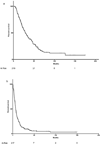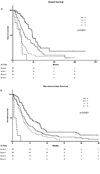Colorectal Cancer Liver Metastases and Concurrent Extrahepatic Disease Treated With Resection
- PMID: 28009741
- PMCID: PMC4942404
- DOI: 10.1097/SLA.0000000000001624
Colorectal Cancer Liver Metastases and Concurrent Extrahepatic Disease Treated With Resection
Abstract
Objective: The aim of the study was to evaluate outcomes after resection of colorectal liver metastases (CRLM) and concurrent extrahepatic disease (EHD), and to define prognostic factors.
Background: There is increasing evidence to support resection of liver metastases and concurrent EHD in selected patients. Long-term survival data are lacking, and prognostic factors are not well defined.
Methods: Retrospective review of 219 patients was undertaken between January 1992 and December 2012, who underwent hepatectomy for CRLM and resection of synchronous EHD. Survival outcomes were estimated by the Kaplan-Meier method. Univariate and multivariate analyses of prognostic factors were performed. A scoring system for prognostication was developed.
Results: The median, 3, 5, and 10-year overall survival were 34.4 months, 49%, 28%, and 10%, respectively. Disease recurred in 185 patients (90.2%) at a median of 8 months. There were 8 actual 10-year survivors. The site of EHD affected survival, with portal, retroperitoneal nodes and multiple sites associated with the worst prognoses. The size of the largest CRLM, the number of CRLM, unfavorable site of EHD, and progression of CRLM on neoadjuvant therapy were associated with overall survival on univariate and multivariate analyses. Three variables, assigned 1 point each, were used to create an EHD risk score: largest CRLM greater than 3 cm, greater than 5 CRLM, and unfavorable site of EHD. The resulting score was prognostic of overall and recurrence-free survival.
Conclusions: Long-term survival is possible after resection of liver metastases and concurrent EHD, but true cure is rare. A proposed scoring system may identify patients most likely to benefit from surgery.
Conflict of interest statement
The authors have no conflicts of interest to declare.
Figures
Similar articles
-
Liver resection for metastatic colorectal cancer in patients with concurrent extrahepatic disease: results in 127 patients treated at a single center.Ann Surg Oncol. 2009 Aug;16(8):2138-46. doi: 10.1245/s10434-009-0521-6. Epub 2009 Jun 3. Ann Surg Oncol. 2009. PMID: 19495884 Clinical Trial.
-
Resection of Concomitant Hepatic and Extrahepatic Metastases from Colorectal Cancer - A Worthwhile Operation?Chirurgia (Bucur). 2017 Nov-Dec;112(6):673-682. doi: 10.21614/chirurgia.112.6.673. Chirurgia (Bucur). 2017. PMID: 29288609
-
Systematic review of outcomes of patients undergoing resection for colorectal liver metastases in the setting of extra hepatic disease.Eur J Cancer. 2014 Jul;50(10):1747-1757. doi: 10.1016/j.ejca.2014.03.277. Epub 2014 Apr 21. Eur J Cancer. 2014. PMID: 24767470
-
Liver Resection With Extrahepatic Disease: A Population-Based Analysis of Thoughtful Selection.J Surg Oncol. 2025 Mar;131(3):443-449. doi: 10.1002/jso.27944. Epub 2024 Oct 28. J Surg Oncol. 2025. PMID: 39466980 Free PMC article.
-
Resection of colorectal liver metastases and extra-hepatic disease: a systematic review and proportional meta-analysis of survival outcomes.HPB (Oxford). 2016 Mar;18(3):209-20. doi: 10.1016/j.hpb.2015.12.004. Epub 2016 Feb 1. HPB (Oxford). 2016. PMID: 27017160 Free PMC article.
Cited by
-
Radiomics artificial intelligence modelling for prediction of local control for colorectal liver metastases treated with radiotherapy.Phys Imaging Radiat Oncol. 2022 Sep 13;24:36-42. doi: 10.1016/j.phro.2022.09.004. eCollection 2022 Oct. Phys Imaging Radiat Oncol. 2022. PMID: 36148155 Free PMC article.
-
Metachronous colorectal liver metastasis that occurred 10 years after laparoscopic colectomy: a case report.Surg Case Rep. 2022 Aug 1;8(1):144. doi: 10.1186/s40792-022-01503-9. Surg Case Rep. 2022. PMID: 35909198 Free PMC article.
-
Safety and Feasibility of Additional Tumor Debulking to First-Line Palliative Combination Chemotherapy for Patients with Multiorgan Metastatic Colorectal Cancer.Oncologist. 2020 Aug;25(8):e1195-e1201. doi: 10.1634/theoncologist.2019-0693. Epub 2020 Jun 16. Oncologist. 2020. PMID: 32490570 Free PMC article. Clinical Trial.
-
High expression of Krüppel-like factor 5 is associated with poor prognosis in patients with colorectal cancer.Cancer Sci. 2020 Jun;111(6):2078-2092. doi: 10.1111/cas.14411. Epub 2020 May 5. Cancer Sci. 2020. PMID: 32279400 Free PMC article.
-
Genetic And Morphological Evaluation (GAME) score for patients with colorectal liver metastases.Br J Surg. 2018 Aug;105(9):1210-1220. doi: 10.1002/bjs.10838. Epub 2018 Apr 25. Br J Surg. 2018. PMID: 29691844 Free PMC article.
References
-
- Ito K, Govindarajan A, Ito H, et al. Surgical treatment of hepatic colorectal metastasis: evolving role in the setting of improving systemic therapies and ablative treatments in the 21st century. Cancer J. 2010;16:103–110. - PubMed
-
- Tomlinson JS, Jarnagin WR, DeMatteo RP, et al. Actual 10-year survival after resection of colorectal liver metastases defines cure. J Clin Oncol. 2007;25:4575–4580. - PubMed
-
- Nikfarjam M, Shereef S, Kimchi ET, et al. Survival outcomes of patients with colorectal liver metastases following hepatic resection or ablation in the era of effective chemotherapy. Ann Surg Oncol. 2009;16:1860–1867. - PubMed
-
- House MG, Ito H, Gonen M, et al. Survival after hepatic resection for metastatic colorectal cancer: trends in outcomes for 1,600 patients during two decades at a single institution. J Am Coll Surg. 2010;210:744–752. 752-745. - PubMed
Publication types
MeSH terms
Grants and funding
LinkOut - more resources
Full Text Sources
Other Literature Sources
Medical



